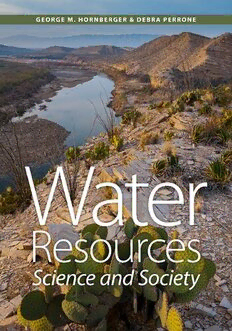Table Of ContentWater Resources
This page intentionally left blank
Water Resources
Science and Society
GEORGE M. HORNBERGER & DEBRA PERRONE
JOHNS HOPKINS UNIVERSITY PRESS Baltimore
© 2019 Johns Hopkins University Press Special discounts are available for bulk purchases of this
All rights reserved. Published 2019 book. For more information, please contact Special Sales at
Printed in Canada on acid- free paper 410-516-6936 or specialsales@press . jhu . edu.
9 8 7 6 5 4 3 2 1
Johns Hopkins University Press uses environmentally
Johns Hopkins University Press friendly book materials, including recycled text paper that
2715 North Charles Street is composed of at least 30 percent post- consumer waste,
Baltimore, Mary land 21218-4363 whenever pos si ble.
www . press . jhu . edu
Library of Congress Cataloging-in-Publication Data
Names: Hornberger, George M., author. | Perrone, Debra,
author.
Title: Water resources : science and society / George M.
Hornberger and Debra Perrone.
Description: Baltimore : Johns Hopkins University Press,
2019. | Includes bibliographical references and index.
Identifiers: LCCN 2019004930 | ISBN 9781421432953
(paperback : alk. paper) | ISBN 1421432951 (paperback :
alk. paper) | ISBN 9781421432960 (electronic) |
ISBN 142143296X (electronic)
Subjects: LCSH: Water-supply.
Classification: LCC TD345 .H59 2019 | DDC 333.91—dc23
LC record available at https://lccn.loc.gov/2019004930
A cata log rec ord for this book is available from the British
Library.
CONTENTS
Preface vii
I Water Availability: A Physical Science Primer
1. The Hydrological Cycle 3
2. Surface Water Resources 20
3. Groundwater Resources 40
4. Soil Water Resources 60
II Demand- Side Sectors
5. Agricultural Water Use 75
6. Energy Water Use 102
7. Domestic Water Use 130
8. Environmental Water Use 144
III Anthropogenic D rivers of Change
9. Population 159
10. Climate Change 179
11. Water Law 190
12. Water Quality 209
IV Water Resources Supply and Demand in Context
13. Opportunities for Water Management 229
Appendix: Units, Dimensions, and Conversions 251
Glossary 257
Index 265
This page intentionally left blank
PREFACE
How much water is there on Earth, and how is it distributed over
space and time? How much w ater do h umans need, and how much
does the environment need? What changes in the f uture w ill affect
the ability of people to use water sustainably?
Water moves through the global hydrological cycle and supplies
the fresh w aters contained in rivers, lakes, groundwater, and soil
water and that are used by plants and animals. Basic information
about the volumes and flows of these water resources is the un-
derpinning for understanding the supply sector for w ater and is
the subject of Part I of this book.
Several primary uses of water that are essential for civilization
are to grow food, produce energy, provide needs for drinking,
bathing, cooking, and so on, and maintain healthy ecosystems.
These needs for water are cornerstones of the demand sector for
water. The material for Part II provides a primer on each sector
and introduces trade-offs involving reliability, economics, the en-
vironment, and water use.
Matching supply and demand is the essence of water resources
management. As we move farther into the twenty- first c entury,
pressures on w ater resources w ill increase and affect management
options. Population growth, climate change, implementations of
water law, and deterioration of water quality all will act as con-
straints. These are topics covered in Part III.
One last question remains: How can knowledge about physical
and social systems be harnessed to manage w ater resources? The
final chapter of the book provides an overview of opportunities
to manage water sustainably in the future in the face of unavoid-
able trade- offs.
Our goal is to introduce twenty- first century water resources
issues to undergraduate students from across a wide spectrum of
disciplines, including natu ral (environmental) sciences, social
viii Preface
sciences, and humanities. This book fits between the two bookends
of being highly technical for advanced hydrology, engineering
optimization, or law courses and being a completely descriptive
summary of issues. It covers basic methods and includes illustra-
tive quantitative calculations and qualitative think-p ieces. It covers
calculations related to water bud gets. It covers data and calcula-
tions used to inform decisions about allocation of water resources.
It contains case studies that illustrate key princi ples of water law.
Several conventions are used to make the text user friendly.
Each chapter concludes with a summary of key points. Boxes are
included in many chapters to illustrate concepts introduced in the
main text. Each chapter has a set of example prob lems based on
the material covered. An appendix provides a review of units,
dimensions, and conversions useful for addressing each chapter’s
example prob lems. And, fin ally, terms in boldface are included in
the glossary.
We are grateful for the comments from our editors, colleagues,
anonymous reviewers, and f amily. We are thankful to our students
and teaching assistants for test- driving the material and working
through the prob lem sets.
This book was a true collaboration with each author contribut-
ing equally.
I
Water Availability:
A Physical Science Primer

